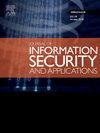Compression-enhanced Three-Pass Protocol for secure and bandwidth-efficient image transmission
IF 3.7
2区 计算机科学
Q2 COMPUTER SCIENCE, INFORMATION SYSTEMS
Journal of Information Security and Applications
Pub Date : 2025-08-25
DOI:10.1016/j.jisa.2025.104204
引用次数: 0
Abstract
Key-based cryptography faces persistent challenges in secure key distribution and newly rising vulnerabilities. Three-Pass Protocols (3PPs) tackle these issues through commutative encryption but typically triple bandwidth requirements. This paper addresses these bandwidth limitations by integrating an entropy-regularized Vector Quantized Variational Autoencoder (VQ-VAE) into a Fresnel-transform-based 3PP. Our VQ-VAE, trained on the Flickr8k dataset, achieves high-quality compression (average PSNR 31 dB, average MS-SSIM 0.96) at an average low bitrate ( 0.35 bpp), reducing 3PP bandwidth requirements by over 97%. Comparative analysis at about 0.3 bpp demonstrates its competitive performance with recent state-of-the-art image compression techniques, and ablation studies validate the contribution of each key component to its overall efficacy. Compressed latent representations are then encrypted via commutative Fresnel transforms, enabling secure, keyless decryption. Security analysis reveals minimal correlation coefficient () between original and encrypted latents, while decrypted latents fully recover the originals (CC ). The final reconstructed images maintain high fidelity (CC ). Furthermore, encrypted latents exhibit negligible adjacent-pixel correlation ( 0.05), highlighting strong immunity to statistical attacks. Histogram analysis shows a high Kullback–Leibler (KL) divergence ( 3.29) and a low histogram intersection (0.597) between ciphers and original latents, underscoring robust resistance to frequency-based methods. Sensitivity analysis reveals that a minute deviation in the diffraction distance ( m) severely degrades decryption quality (CC 0.05), demonstrating resistance against brute-force attacks. A lightweight verification step thwarts replay attacks, a known 3PP weakness. This framework enables secure and bandwidth-efficient image transmission, making it suitable for resource-constrained and security-critical applications such as telemedicine and remote-sensing downlinks.
压缩增强的三通道协议,用于安全和带宽高效的图像传输
密钥加密在安全密钥分发和新出现的漏洞方面面临着持续的挑战。三通协议(3PPs)通过交换加密解决了这些问题,但通常需要三倍的带宽。本文通过将熵正则化矢量量化变分自编码器(VQ-VAE)集成到基于菲涅耳变换的3PP中来解决这些带宽限制。我们的VQ-VAE在Flickr8k数据集上进行了训练,在平均低比特率(< 0.35 bpp)下实现了高质量的压缩(平均PSNR≈31 dB,平均MS-SSIM≈0.96),将3PP带宽需求降低了97%以上。在约0.3 bpp的情况下,对比分析表明其与最新的图像压缩技术具有竞争力,消融研究证实了每个关键组件对其整体功效的贡献。然后通过交换菲涅耳变换对压缩的潜在表示进行加密,从而实现安全的无密钥解密。安全分析显示,原始潜伏与加密潜伏之间的相关系数最小(CC<0.04),而解密潜伏完全恢复原始潜伏(CC =1.0)。最终重建的图像保真度较高(CC >0.98)。此外,加密的潜伏表现出可忽略不计的邻接像素相关性(< 0.05),突出了对统计攻击的强免疫力。直方图分析显示,密码与原始潜势之间具有较高的Kullback-Leibler (KL)散度(> 3.29)和较低的直方图交集(0.597),强调了对基于频率的方法的强大抵抗力。灵敏度分析表明,衍射距离(10−5 m)的微小偏差会严重降低解密质量(CC < 0.05),显示出对暴力攻击的抵抗力。轻量级验证步骤可以阻止重放攻击,这是3PP的一个已知弱点。该框架可实现安全和带宽高效的图像传输,使其适用于资源受限和安全关键型应用,如远程医疗和遥感下行链路。
本文章由计算机程序翻译,如有差异,请以英文原文为准。
求助全文
约1分钟内获得全文
求助全文
来源期刊

Journal of Information Security and Applications
Computer Science-Computer Networks and Communications
CiteScore
10.90
自引率
5.40%
发文量
206
审稿时长
56 days
期刊介绍:
Journal of Information Security and Applications (JISA) focuses on the original research and practice-driven applications with relevance to information security and applications. JISA provides a common linkage between a vibrant scientific and research community and industry professionals by offering a clear view on modern problems and challenges in information security, as well as identifying promising scientific and "best-practice" solutions. JISA issues offer a balance between original research work and innovative industrial approaches by internationally renowned information security experts and researchers.
 求助内容:
求助内容: 应助结果提醒方式:
应助结果提醒方式:


